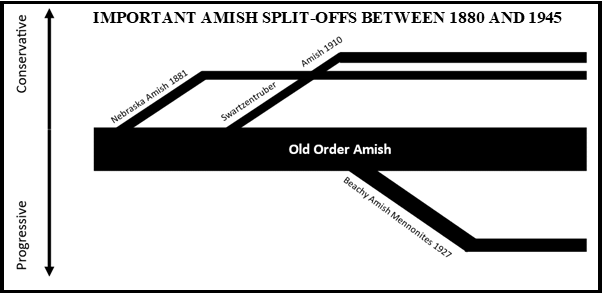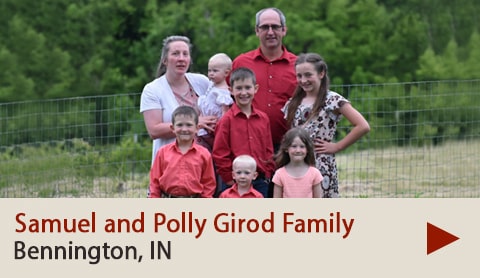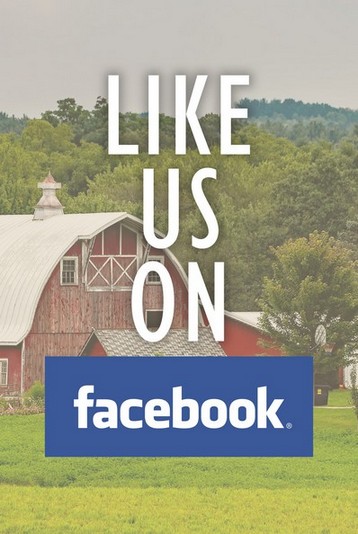History of the Amish (Part 10)
By Magda Adriana
November 1, 2024
 History of the Amish Series
History of the Amish Series
Part 1
Part 2
Part 3
Part 4
Part 5
Part 6
Part 7
Part 8
Part 9
Part 10
Part 11
The previous article showed how the Amish church split gradually during the second half of the 19th century. The progressive-minded Amish took on the name “Amish Mennonites,” and during the end of the 19th century and the beginning of the 20th, they moved more toward the Mennonites. Eventually, all Amish Mennonite churches dropped the name “Amish” or merged with neighboring Mennonite churches.
Close Connections Among the Old Order Amish
(Despite Geographical Distances)
We will focus on the group called “Old Order Amish” since they put much value on the Ordnung as the guideline for unity in the local congregation. The Old Order Amish continued to be a church where the local congregation had the final say in matters. Ordnungs differed slightly from church to church, but a great sense of unity was noticeable among the Old Order churches. The Budget, a local newspaper in Sugar Creek, Ohio, also stimulated this unity. During its first years, it was mainly an Amish Mennonite newspaper owned by an Amish Mennonite family. However, about one-third of its readers were Old Order Amish and news from the scattered settlements came in through the readers' letters. Because the Amish Mennonites became increasingly closer with the Mennonites and started subscribing to the Mennonite newspapers, the Budget became more of an Old Order Amish newspaper. Also, the Amish Mennonite family who owned the business sold it to a Lutheran man with strong ties to the local Old Order Amish, contributing to the shift. Since 1946, there has been a local version with news from Sugar Creek and a national version that contains only the scribes’ reports and thus became the Old Order Amish newspaper (although in 1975, there came a similar newspaper, Die Botschaft in Pennsylvania – Some scribes write for both papers).
New Split-Offs
Although there was a great sense of unity, this was not the case in all communities. Drifting and split-offs occurred both on the more progressive side as well as on the conservative side. For example, the Old Order Amish in Johnson County, Iowa, decided to have meeting houses instead of gathering in homes for Sunday worship services. They explicitly stated that this did not mean they intended to shift towards the Amish Mennonites. Nevertheless, within a few decades, that is exactly what they did: joined the Amish Mennonites. During the same period, the Old Order Amish in Somerset County, Pennsylvania, built meeting houses. However, they remained Old Order.
Some Amish felt that even the Old Orders were not strict enough in their Ordnungs or in implementing them. Those Amish decided to form new groups: the Nebraska Amish (1881) in Mifflin County, PA (named after the Nebraska bishop who helped organize their fellowship) and the Swartzentruber Amish (1913) in Apple Creek, OH (named after a later influential bishop). The Nebraska Amish are also called “Weiss-Wegli-Leit” because of their remarkable white-topped buggies.

There were also splits because some people felt the Old Order Amish were too strict. Under the guidance of Bishop Peachey, a breakaway group in Pennsylvania did away with strict shunning and accepted in-home telephones and electricity. This group was nicknamed the “Peachey Church.” They allowed car use and ownership once cars became available for the common people. Before 1910, Old Order Amish had not arrived at a complete consensus on the use and abuse of new gadgetry, but the eager embrace of change by the Peachey faction helped incorporate technological cautions and prohibitions more decidedly within the Old Order Church’s Ordnung. Thus, the withdrawal of a minority group of Lancaster progressives helped to unite the majority along more conservative lines. Although the Peachey group easily accepted technological progress, they did keep the simple Amish dress style.
In 1927, a similar split occurred in Somerset County, Pennsylvania. Strict shunning was also the main reason for this split. In this case, the group that would remain Old Order split away from the main congregation. The larger, more lenient group was under the leadership of Bishop Beachy, and therefore got the name “Beachy Amish.” Soon, this group was affiliated with the Peachey group. Because of the acceptance of modern technology, which is not typically Amish, the group was also called “Beachy Amish Mennonites.” This group is not seen as Amish by many other Amish, and most of today’s members would rather identify as Mennonites. However, their plain-colored dress style still traces them back to their Amish roots.
Primary source: “A History of the Amish” by Steven M. Nolt
« Back to Articles






